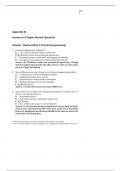Exam (elaborations)
Appendix III Answers to Chapter Review Questions
- Course
- Institution
Appendix III Answers to Chapter Review Questions Chapter 1 Review: What Is Chemical Engineering? 1 2 3 Chemical engineering is a blend of: A __Lab work and textbook study of chemicals B X Chemistry, math, and mechanical engineering C __Chemical reaction mechanisms and equipment re...
[Show more]



